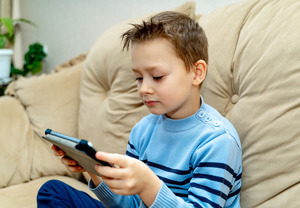
In this day and age, it’s common for children to spend a lot of their free time staring at a tablet or another type of electronic screen. However, this habit can ultimately have a negative impact on their vision, especially if they already have myopia. Research has shown that an excessive amount of screen time could potentially cause your child’s nearsightedness to progress at a faster rate; here’s what you need to know as a parent.
How Screen Time Can Affect Myopia
In recent years, myopia has grown far more prevalent; this correlates with how people of all ages are spending more time in front of computers, cell phones, and other electronic screens. One of the theories for this connection is that focusing on a screen or another nearby object for a prolonged period of time can contribute to the elongation of the eye. The longer the eyeball gets, the worse myopia becomes.
Additionally, if your child is spending a lot of time in front of screens, they most likely aren’t going outside enough. There’s evidence that too much time indoors can contribute to the progression of nearsightedness. Regular exposure to natural light is needed for proper eye development.
How Can You Slow Down Your Child’s Myopia Progression?
If myopia goes unmanaged, it can potentially put your child at a higher risk for serious vision problems such as glaucoma or even retinal detachment. As such, it’s important to do what you can to slow down the progression of the condition while your child is still growing.
One simple step you can take is to limit the amount of time your little one spends in front of electronic screens. You can do so by having them go outside for at least an hour every day and taking them with you when you go to run errands. On top of that, you can teach your child to give their eyes a break from staring at screens by looking away every 20 minutes to look at an object that’s 20 feet away for 20 seconds.
It’s also worth talking to your child’s optometrist to see if there are any forms of treatment they may recommend that can slow the progression of myopia. For example, some young patients may benefit from orthokeratology, which involves the use of special contact lenses that adjust the shape of the cornea, resulting in clearer distance vision during the day.
By encouraging the right habits and being proactive about seeking treatment, you can help your child keep their myopia under control, which can go a long way toward improving their overall quality of life.
About the Author
Dr. Jordana Chettiparampil is a licensed Therapeutic Optometrist who provides children with the quality vision care that they deserve. She specializes in myopia control for kids, and to that end, she offers orthokeratology along with other forms of treatment. To schedule a consultation with Dr. Chettiparampil at Richmond Eye Experts, visit her website or call (832) 685-2020.

